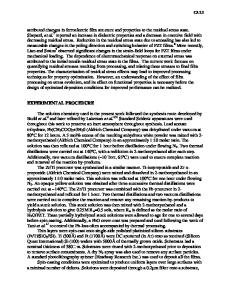Stress Gradients and Anisotropy in Thin Films
- PDF / 948,452 Bytes
- 6 Pages / 420.48 x 639 pts Page_size
- 49 Downloads / 365 Views
STRESS GRADIENTS AND ANISOTROPY IN THIN FILMS ROBERT M. FISHER, J. Z. DUAN, and ALAN G. FOX
Center for Advanced Materials, Lawrence Berkeley Laboratory, University of California, Berkeley, CA 94720 ABSTRACT
Indications that steep through-thickness strain gradients occur in vapourdeposited chromium films stemming from previous observations of film curling during spontaneous delamination from substrates, have been substantiated by analysis and simulation of Bragg X-Ray diffraction peaks. The presence of large throughthickness compressive strains, that increase quadratically with distance from the substrate from about zero at the interface to around 0.8% at the film surface, was deduced by empirical computer matching of diffraction peak shapes. INTRODUCTION
Quantitative interpretation of spontaneous, i.e. residual stress-driven, delamination of thin films from substrates requires precise knowledge of the internal stress state at the interface and throughout the film [1]. The direction and magnitude of stresses in films on substrates can be determined by measurements of substrate distortion. However, any preferred crystallographic texture, steep through-thickness stress gradients or large in-plane stress anisotropy, as well as the occurrence of any brittle, ductile or diffusive stress relaxation processes during or subsequent to film deposition can lead to an erroneous interpretation of substrate bending [2,3]. On the other hand, measurements of residual stresses in crystalline materials by x-ray diffraction are less influenced by localized film relaxation and particularly by cracking. STRAIN MEASUREMENTS
BY X-RAY DIFFRACTION
Representative tracings of 110 Bragg peaks from several thin Cr films vapordeposited on glass substrates are presented in Figure 1 along with the peak from a reference sample of annealed Cr powder. The large shift in peak position reveals that lattice planes parallel to the surface are in compression with a mean strain of about 0.5%, i.e. the films are in tension. The considerable broadening of the lines is indicative of a substantial range of elastic strains in the films (the pronounced asymmetry of the peaks derives from non-uniformities within the films as discussed below). The observed broadening is a composite of effects due to the fine grain size and non-uniform strain in the films, as well as instrument broadening, is given by [4], B2t
B
2 B2s
2
= BI +BS+BAE
(1)
The grain size broadening BGS and non-uniform strain broadening B(Ae) are given by, BGS
kex
(2)
t* COSOB
and B(Ae)
=
-2 (A-d)tanO8
(3)
Subtracting instrument broadening, established with a well-annealed, coarse grain standard, and rearranging terms gives, Mat. Res. Soc. Symp. Proc. Vol. 130.
i1989Materials Research Society
250
CHROMIUM FILMS ON GLASS
Fig. 1. X-Ray diffraction
>.
peaks (110 bcc - Cu K
z w Iz_
alpha) for thin Cr films vapour-deposited on glass - superimposed
peak from annealed Cr powder.
TWO THETA - Degrees
BCos 2_ 2
2
2= 2
k2 k2
2
Ad sin22
/~2
k~-) ( d X2
(4)
2
oB-Bi ,t is the
Data Loading...









